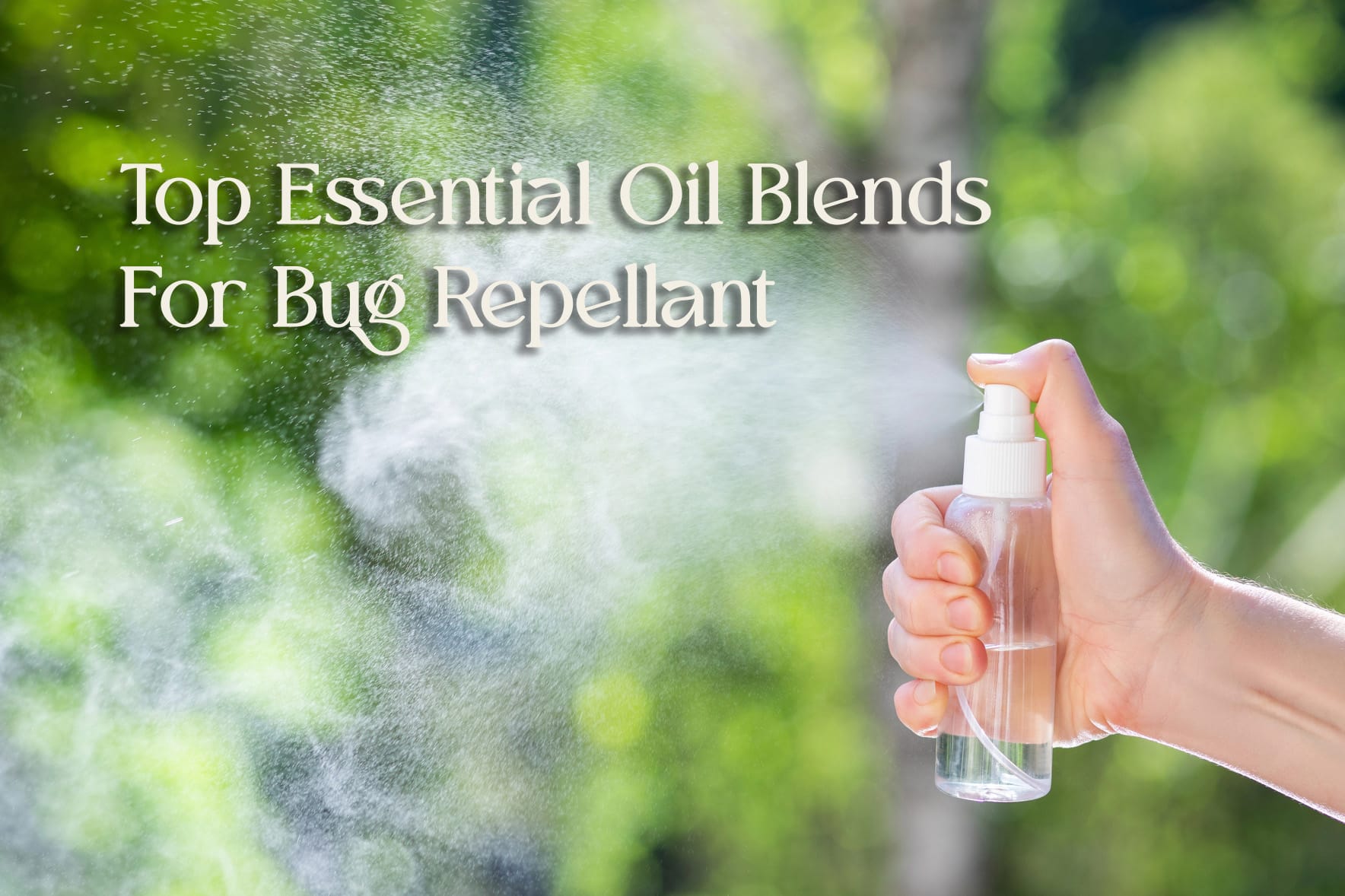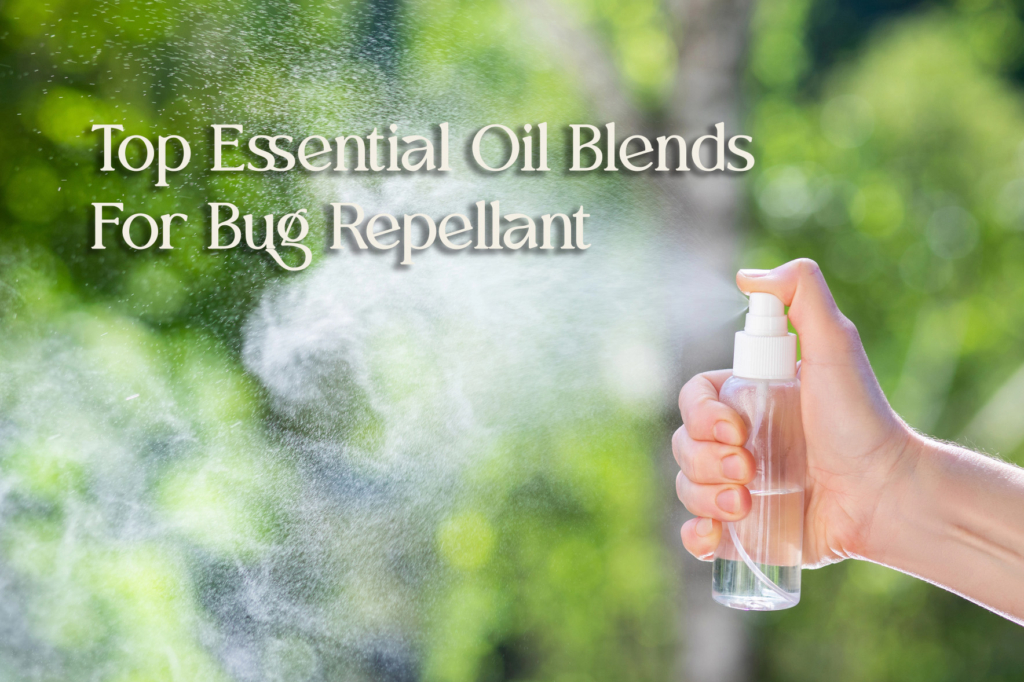
Summer is finally here! And with it, the sweet return of long, golden days spent outdoors. Whether you're hiking through sunny trails, swimming in crystal-clear lakes, camping under the stars, or simply savoring a quiet moment on the patio with your favorite iced tea, there's nothing quite like this season's invitation to reconnect with nature.
But just as you're settling into the joy of it all, you hear that familiar buzzzz – along come the bugs. Mosquitoes, gnats, flies, and other pesky insects can quickly turn a dreamy outdoor adventure into an itchy, swatting frenzy. The good news is you don’t have to reach for that sticky, chemical-filled bug spray that smells like a science experiment. There’s a gentler, more pleasant solution: essential oils.
Aromatic plants have been used for centuries to keep insects away, whether burned, strung around doorways, diffused, infused, or worn on the skin. Today, we know that many of these traditional remedies are backed by science. Certain aromatics can be just as effective as conventional repellents, and they smell a whole lot better! Not to mention, many aromatic plants offer powerful therapeutic benefits – not just for the physical body, but for the mind and spirit as well.
In this post, we’ll dive into the science behind essential oils for bug repellent, plus reveal the top 10 aromatic plants to keep the bugs away. We’ll also share some of our favorite aromatherapy blends for repelling bugs naturally, so you can enjoy every moment outdoors without those unwanted buzzing guests.
Why Choose Aromatherapy for Bug Repellent?
Conventional bug sprays often contain harsh chemicals like DEET, leaving many of us wondering what we’re really putting on our skin (and breathing in). Aromatherapy offers a natural, plant-based alternative that’s not only effective but also gentle, eco-friendly, and multi-functional. Many essential oils commonly used to repel insects also offer added benefits like calming the nervous system, cooling the body, or uplifting the mood.
When it comes to natural bug repellents, it can be hard to know just how effective certain aromatic plants truly are, largely due to limited scientific studies. But promising new research is emerging. In a 2023 study from New Mexico State University (NMSU), researchers tested 20 different essential oils, each diluted to 10% in a lotion base, to evaluate their mosquito-repelling power. Each formulation was applied to volunteers' skin, and then their arms were placed inside a cage with 25 hungry mosquitoes (pretty much a nightmare scenario). The scientists measured the protection time as the moment the volunteer received their first bite.
The results suggest that aromatic plant-based repellents can be effective at preventing mosquito bites (particularly in low-risk environments), as long as they’re reapplied regularly. It’s a great reminder that natural solutions can work, especially when used mindfully and consistently. Let’s explore the top 10 essential oils for repelling bugs.
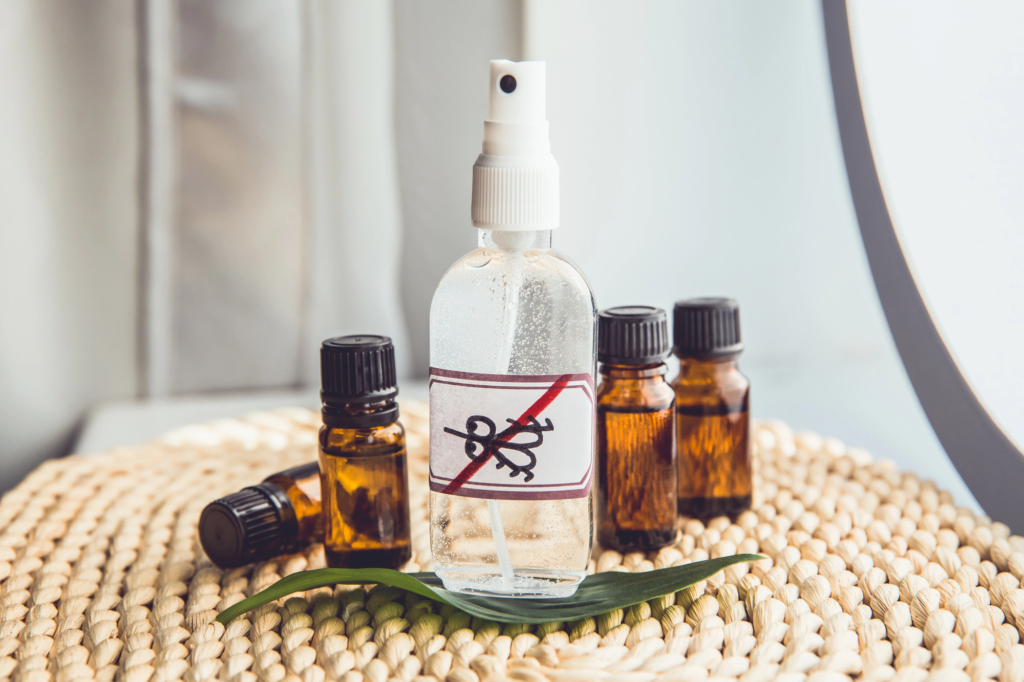
How to Use Aromatics for Insect Repellent
There are several ways to harness the power of aromatic plants and essential oils for bug repellent. The simplest is a natural spray made with essential oils. These are convenient and easy to use, but tend to evaporate quickly and need frequent reapplication. For longer-lasting coverage, try using aromatic oil infusions or herbal salves, thicker preparations that linger on the skin thanks to their base of oils or waxes. (Want to make your own aromatic oil infusions and salves? Click here to learn more.)
Another lovely option, especially when you're relaxing outdoors at a campsite or on a patio, is to diffuse essential oils or burn natural incense. Not only do many bugs dislike the aroma of certain plants, but they also avoid smoke, so incense pulls double duty: it smells wonderful and keeps the pests away.
Top 10 Essential Oils for Bug Repellent
Clove (Syzygium aromaticum)
In the NMSU study, Clove essential oil stood out as one of the most effective natural options for bug repellent, offering up to one hour of protection against mosquitoes [1]. Its strong, spicy aroma comes from eugenol, a powerful aromatic compound traditionally used for its antiseptic, antimicrobial, and cleansing properties. Beyond mosquitoes, Clove has also been known to help repel ticks, wasps, flies, fleas, aphids, cockroaches, and other unwelcome insects, making it a versatile aromatic in any natural bug-repelling blend.
Note: According to Tisserand and Young, the maximum recommended dermal limit for Clove essential oil is 0.5% in leave-on products like lotions, oils, or sprays [3]. Clove oil can be irritating, so proper dilution with a carrier oil is essential for safe use.
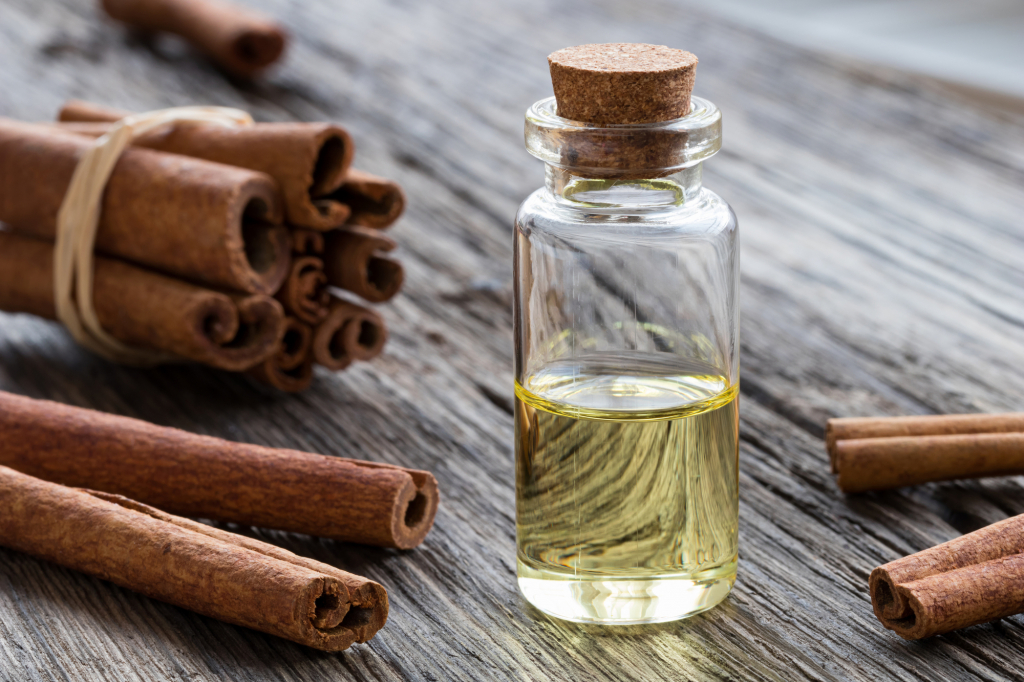
Cinnamon (Cinnamomum spp.)
Cinnamon essential oil ranked as the second most effective mosquito repellent in the NMSU study, offering up to one hour of protection [1]. Like Clove, it contains eugenol, a natural compound with insecticidal and pesticidal properties. Cinnamon is also known to help deter ticks, ants, cockroaches, and other persistent pests. In aromatherapy, Cinnamon is considered a gentle, balancing herb in the emotional realm. The aroma of Cinnamon can break up thoughts or feelings of stagnation, especially when you are feeling stuck in a thought cycle or “stuck in a rut.”
Note: Cinnamon essential oil is highly potent and can easily irritate the skin, even when diluted. Cinnamon bark oil, in particular, is generally not recommended for topical use. If you do choose to use it, the maximum safe dilution is 0.05%. Cinnamon leaf oil is slightly milder but should still be used with caution, and should not exceed a 0.5% dilution. Avoid using any form of Cinnamon oil on children under 2 years of age.
Palmarosa (Cymbopogon martinii)
The NMSU study identified geraniol oil as an effective mosquito repellent, offering up to one hour of protection [1]. Geraniol is a naturally occurring compound found in many aromatic plants, including Rose, Geranium, Citronella, and Palmarosa (which happens to be one of the richest sources, containing 70–85% geraniol). Palmarosa essential oil has a fresh, floral, and slightly sweet aroma, with rosy and grassy undertones. Often described as a cross between Rose and Lemongrass, it brings both beauty and function to bug-repelling blends.
Beyond its insect-repelling powers, Palmarosa is widely used in natural skincare for its antimicrobial, antioxidant, and anti-inflammatory properties. In aromatherapy, it's cherished for its ability to soothe stress, anxiety, grief, and emotional fatigue, offering gentle support to the nervous system.
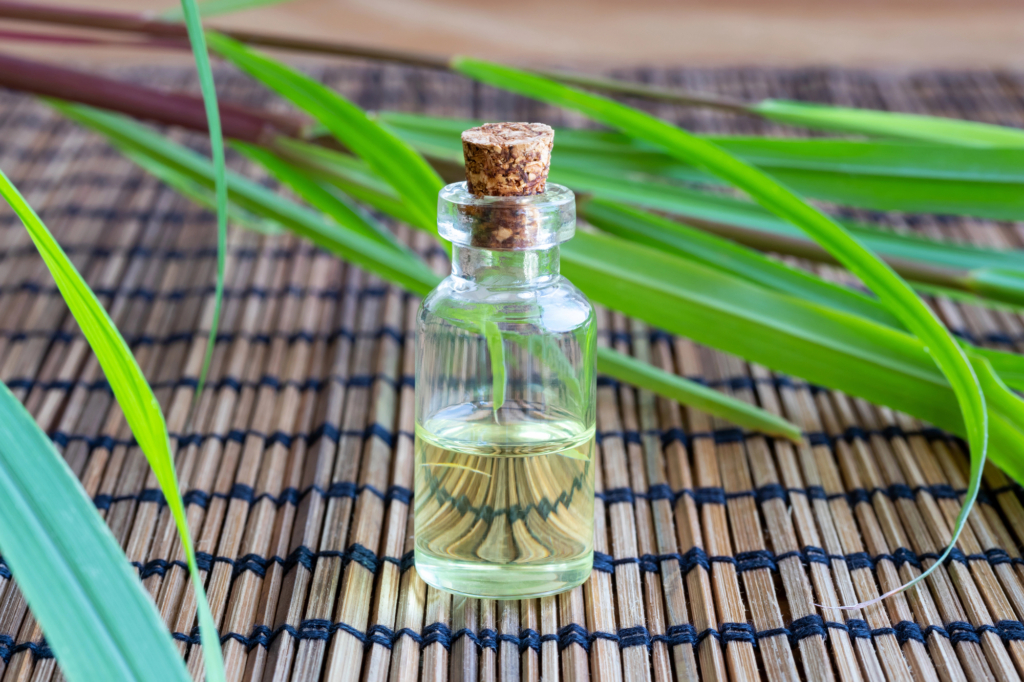
Lemongrass (Cymbopogon citratus)
The NMSU study found that Lemongrass essential oil provided up to 30 minutes of protection against mosquitoes [1]. Additionally, a 2010 review of essential oils for insect repellent use highlighted Lemongrass as one of the most consistently effective oils cited across multiple studies.
Lemongrass contains small amounts of geraniol (typically 1–7%, depending on the variety and growing conditions), and it’s especially valued for its high content of citronellal, a key compound known to repel mosquitoes, ticks, and other biting insects. Its bright, citrusy, and slightly earthy aroma is refreshing and uplifting to the mood, and makes it a popular choice in both bug-repelling blends and natural perfumery.
Lavender (Lavandula spp.)
Lavender is widely known for its calming, stress-relieving properties, but it’s truly one of the most versatile plants in the aromatic world. In addition to its emotional support, Lavender is believed to help repel mosquitoes, moths, black flies, gnats, and fleas, making it a gentle yet effective option for natural bug-repelling blends.
Its anti-inflammatory and skin-soothing properties make it especially helpful if a bite does occur, helping to reduce itching, swelling, and discomfort. In aromatherapy, Lavender is often used to ease anxiety, restlessness, and tension, and can be especially supportive when the heat, bites, and irritations of summer start to wear on the nervous system.

Unlock Your Free Sneak Peek Access To...
🌿 The Aromatic Medicine Garden Membership 🌿
Are you ready for a deeper holistic dive into the world of aromatic plants? See what our membership is all about with your free sneak peek into videos about Lavender & other herbs, plus foundational herbal & aromatic medicine lessons full of valuable insights.
Peppermint & Spearmint (Mentha spp.)
Peppermint and Spearmint are more than just refreshing herbs for summertime; they’re also effective natural insect repellents. Most bugs dislike the sharp, penetrating aroma of Peppermint, including mosquitoes, spiders, roaches, moths, flies, and ants. The secret lies in menthol, a key compound in Mint that not only repels insects but also helps relieve itching and irritation from bites when applied topically. The 2023 NMSU study found that both Peppermint and Spearmint essential oils offered up to 30 minutes of protection against mosquitoes [1].
Peppermint oil contains about 40% menthol, making it a strong, invigorating choice when you need extra bug protection, while Spearmint contains only about 0.5% menthol, offering a softer, more gentle alternative, ideal for those sensitive to menthol or who find Peppermint too intense. As an added bonus, the cooling nature of menthol makes Mint a perfect antidote for hot summer days.
Rose Geranium (Pelargonium graveolens)
Rose Geranium is a powerhouse when it comes to natural insect repellent, particularly effective against ticks and mosquitoes. In the 2023 NMSU study, Rose Geranium essential oil provided up to 30 minutes of protection against mosquitoes [1]. It typically contains between 5% and 20% geraniol, a key compound known for its insect-repelling and antimicrobial properties.
Beyond its bug-fighting abilities, Rose Geranium is beloved in aromatherapy for its emotionally balancing, heart-soothing effects. It’s often used to ease anxiety, irritability, and emotional imbalances, and its soft, rosy-green scent is both grounding and uplifting. This makes it a beautiful addition to summertime blends, helping you feel centered and calm, even when the bugs are buzzing.
Citronella (Cymbopogon nardus)
Citronella is probably the most well-known aromatic plant when it comes to bug repellent, and for good reason! You’ve likely spotted Citronella candles or tiki torches lining store shelves every summer. This essential oil is steam-distilled from Citronella grass (Cymbopogon nardus), a tropical plant native to Asia. It’s often confused with its close cousin, Lemongrass (Cymbopogon citratus), and while their scents are similar, both are highly effective natural insect repellents. In the 2023 NMSU study, Citronella essential oil provided up to 30 minutes of protection against mosquitoes [1]. It also contains geraniol, one of the key aromatic compounds responsible for its insect-repelling power.
Beyond keeping bugs at bay, Citronella has antimicrobial and antifungal properties, making it a popular choice in natural cleaning and body care products. And bonus: it’s known to have uplifting, mood-boosting effects, which can be a much-needed perk when you’re feeling irritated by pesky insects!

Eucalyptus (Eucalyptus spp.)
It’s no surprise that the cleansing, camphorous aroma of Eucalyptus is an effective natural insect repellent. Eucalyptus is believed to help ward off mosquitoes, roaches, ants, flies, spiders, lice, and more. Its close relative, Lemon Eucalyptus (Corymbia citriodora), is a popular ingredient in many natural bug sprays and is well-known for its powerful insect-repelling properties. A 2010 scientific review identified Eucalyptus as one of the most frequently studied and effective essential oils for bug repellent use [2]. Another study from the same year found that multiple species of Eucalyptus oil were lethal to sandflies, highlighting its broad-spectrum potential [4].
Beyond repelling insects, Eucalyptus is deeply supportive to the body and mind. Traditionally used to ease cold and flu symptoms, it also promotes immune system function, mental clarity, and stress relief. Whether used in a natural incense, diffuser, spray, or topical blend, Eucalyptus offers a refreshing way to protect and uplift.
Important Safety Tips
Essential oils are powerful and highly concentrated, so proper dilution is key, especially for topical use. Applying undiluted oils can lead to skin irritation or sensitization, so always research the specific oil you’re using (including its Latin name) to ensure it’s safe for your intended purpose.
Keep in mind: not all essential oils are safe for topical use; or children, pets, or during pregnancy, so a little homework goes a long way. It’s also wise to perform a patch test before applying any new blend more broadly, just to rule out any sensitivities. Need help figuring out how much to use? Check out our Essential Oil Dilution Guide for expert tips on blending safely.
And don’t forget – natural bug repellents need to be reapplied regularly to stay effective, especially if you’re sweating or swimming! Here are some of our favorite aromatherapy blends for bug repellent.
DIY Aromatherapy Bug Repellent Blends
Outdoor Adventure Bug-Repelling Spray
Ingredients:
12 drops Citronella EO
10 drops Rose Geranium EO
8 drops Lavender EO
5 drops Eucalyptus EO
2 oz witch hazel
Directions:
Add all ingredients to a 4-oz glass spray bottle. Fill the rest with distilled water, and shake well before each use!
Home & Garden Diffuser Bug Blend
Ingredients:
3 drops Cinnamon Leaf EO
2 drops Rose Geranium EO
2 drops Lavender EO
Directions: Add the essential oils in a diffuser to repel bugs near an open window or patio.
On-the-Go Oil Roller Bug-Repelling Blend
Ingredients:
4 drops Peppermint EO
4 drops Citronella EO
2 drops Lavender EO
10 ml jojoba oil
Directions: Add all ingredients into a 10 ml glass roller ball vial and shake well before use! Perfect for your pocket or backpack to apply to the wrists, ankles, or neck during outdoor activities.
Aromatic Armor for the Outdoors
When it comes to keeping bugs at bay, nature has your back – and your skin! Aromatic medicine offers a powerful (and beautiful) way to repel pests without reaching for harsh chemicals. From zesty Citronella to soothing Lavender and cooling Peppermint, these plant allies bring both protection and pleasure to your summer adventures.
Now it’s your turn to get creative. Mix, match, and explore the oils that speak to you – whether you're crafting a cooling body spray, a bug-be-gone salve for hikes, or natural incense for dreamy patio evenings. There’s no one-size-fits-all recipe, so trust your nose, tune in to your intuition, and let the plants guide you.
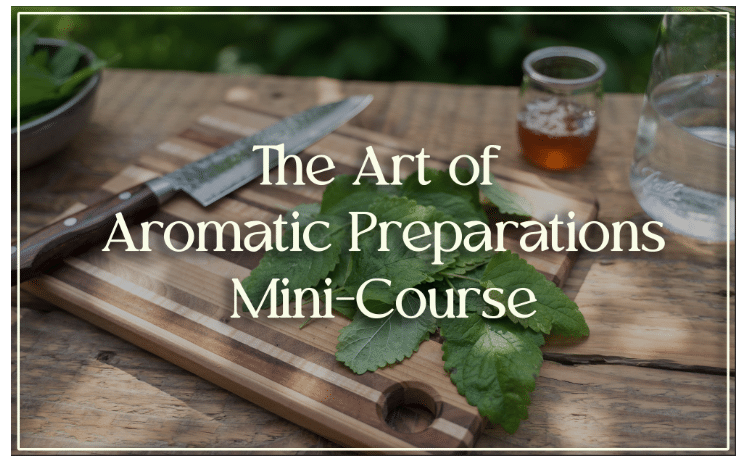
Want to make your own natural bug-repelling herbal salves and oil infusions? Are you ready to take your work with aromatic plants to the next level?
Our Art of Aromatic Preparations Mini-Course is open now! This hands-on mini-course features 6 in-depth video tutorials on foundational aromatic medicine preparations like tinctures, salves, hydrosols, oil infusions, and more. Led by our beloved instructor Erika Galentin, clinical herbalist and aromatherapist, you'll be guided step-by-step through each preparation, with expert insights, tips, and techniques woven throughout.
References
1. Luker, H.A., Salas, K.R., Esmaeili, D. et al. Repellent efficacy of 20 essential oils on Aedes aegypti mosquitoes and Ixodes scapularis ticks in contact-repellency assays. Sci Rep 13, 1705 (2023). https://doi.org/10.1038/s41598-023-28820-9
2. Nerio, L.S., Olivero-Verbel, J., & Stashenko, E. Repellent activity of essential oils: A review. Bioresource Technology, Volume 101, Issue 1, 2010. Pages 372-378. https://doi.org/10.1016/j.biortech.2009.07.048
3. Tisserand, Robert & Rodney Young. Essential Oil Safety: A Guide for Health Care Professionals. Second Edition. Churchill Livingstone.
4. Maciel, M.V., Maia de Morais, S., Maria Leal Bevilaqua, C., Silva, R.A., et. al. Chemical composition of Eucalyptus spp. essential oils and their insecticidal effects on Lutzomyia longipalpis. Veterinary Parasitology 167(1):1-7. Oct. 2009. DOI:10.1016/j.vetpar.2009.09.053
Article Written By Melissa Szaro

© 2025 The Northwest School of Aromatic Medicine. All rights reserved.
*The statements above have not been evaluated by the FDA, and are for educational purposes only. This article is not intended to diagnose, treat, cure, or prevent any disease. This article should not be taken as medical advice. Please consult your physician before you use this information for health purposes.
